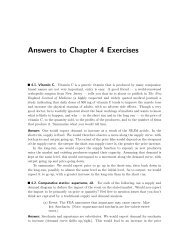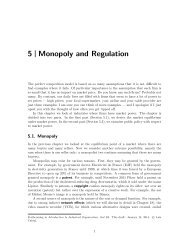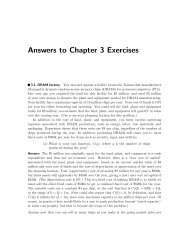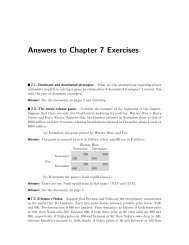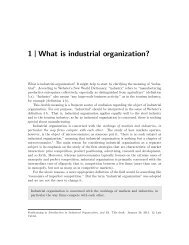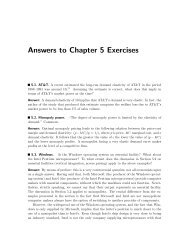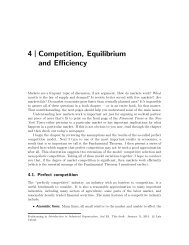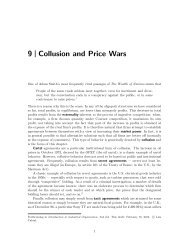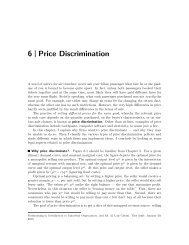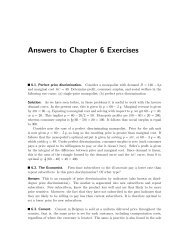8 Oligopoly - Luiscabral.net
8 Oligopoly - Luiscabral.net
8 Oligopoly - Luiscabral.net
Create successful ePaper yourself
Turn your PDF publications into a flip-book with our unique Google optimized e-Paper software.
Give an example of an industry dominated by a couple of firms where profits are significant.<br />
Explain why the predictions of the Bertrand model are not borne out.<br />
8.2. Bertrand and zero profits. According to Bertrand’s theory, price competition<br />
drives firms’ profits down to zero even if there are only two competitors in the market.<br />
Why don’t we observe this in practice very often?<br />
8.3. E-commerce. E-commerce represents an increasing fraction of economic transactions<br />
in many different industries. Does e-commerce create a Bertrand trap? What is<br />
special about e-commerce (and, more generally, the new economy) that makes the Bertrand<br />
trap a dangerous trap? How can e-commerce firms avoid the trap?<br />
8.4. Price discrimination. A monopolist is generally better off by price-discriminating.<br />
What about a duopolist? Consider the special case when Market A is Firm 1’s “strong”<br />
market, whereas market B is firm 2’s “strong” market.<br />
8.5. Cournot model assumptions. Three criticisms are frequently raised against the<br />
use of the Cournot oligopoly model: (i) firms normally choose prices, not quantities; (ii)<br />
firms don’t normally take their decisions simultaneously; (iii) firms are frequently ignorant<br />
of their rivals’ costs; in fact, they do not use the notion of Nash equilibrium when making<br />
their strategic decisions. How would you respond to these criticisms? (Hint: in addition to<br />
this chapter, you may want to refer to Chapter 7.)<br />
8.6. Cournot vs. Bertrand. Which model (Cournot, Bertrand) would you think provides<br />
a better approximation to each of the following industries: oil refining, inter<strong>net</strong> access,<br />
insurance. Why?<br />
8.7. ByeByeCold. You are currently the sole seller of ByeByeCold, a revolutionary drug<br />
that almost instantly eliminates cold symptoms. Although the production cost is only $.10<br />
per dose, you sell ByeByeCold for $1.39 per dose, for a total profit of $900m a year. You<br />
are currently considering licensing ByeByeCold to a second producer. Neither you nor your<br />
competitor have any significant capacity constraints. One of your managers suggested, since<br />
the firm would be sharing the market with a competitor, it would be appropriate to charge<br />
a flat fee that covers half the current profits plus a generous margin; the value of $700m was<br />
suggested. An alternative proposal would be to set a royalty fee of $.50 per dose. What is<br />
your opinion?<br />
8.8. French generics manufacturer. Consider the last problem in Section 8.4. Suppose<br />
that a retailing campaign costing e 80m is expected to increase demand by 40%. Suppose<br />
also that the current rupee/euro exchange rate is 50 INR/e. Should the French firm go<br />
ahead with the campaign? One macroeconomics expert tells you that “it is likely that the<br />
rupee will appreciate in the near future.” How would this influence your decision?<br />
8.9. Karmania automobiles. There are two auto producers in Karmania, F1 and F2.




